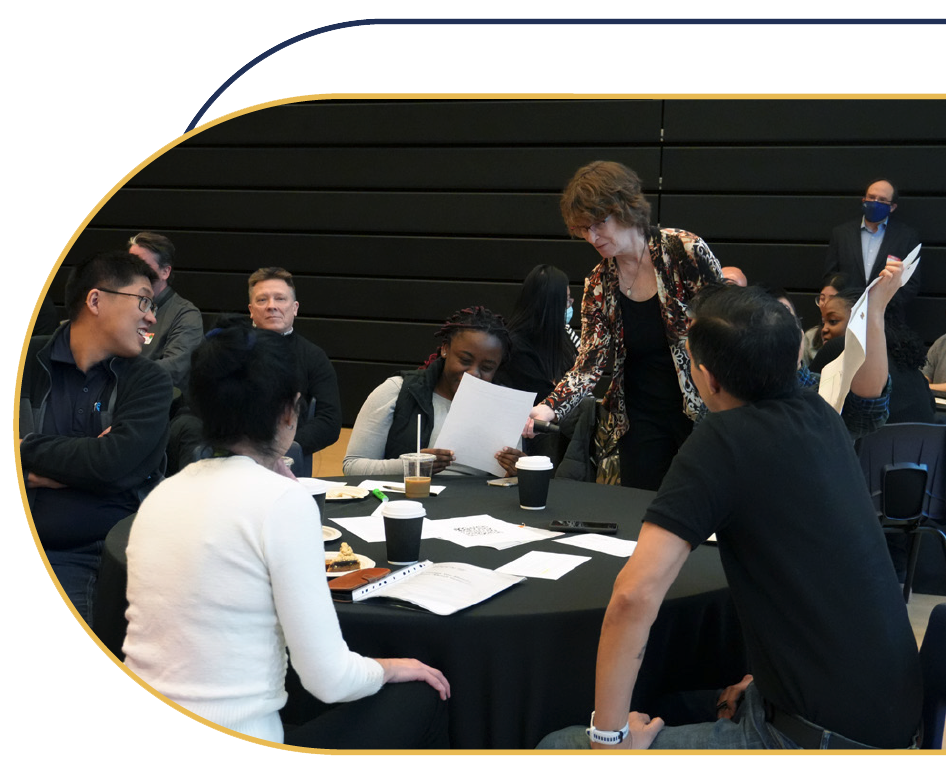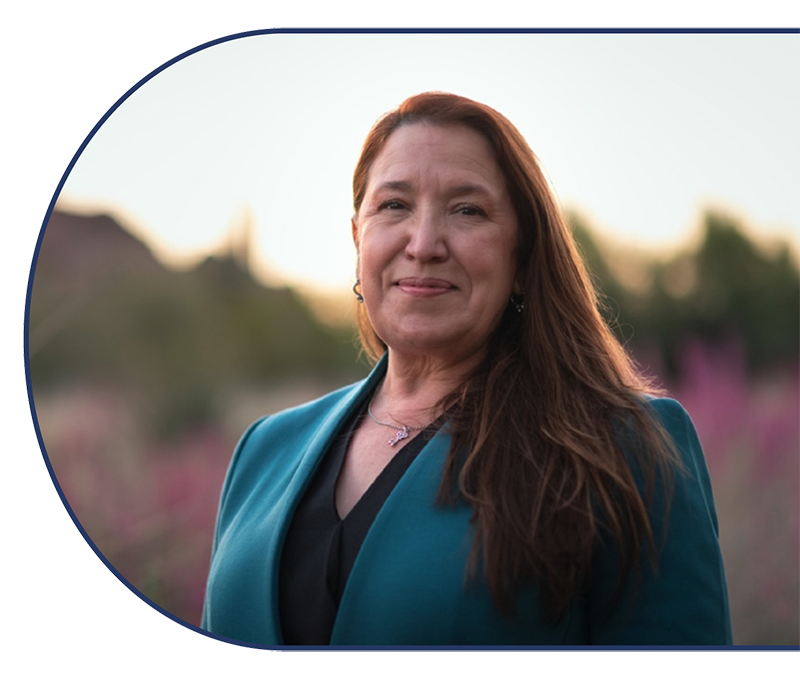
IT@UofT Strategic Plan 2025 to 2027
Next steps
for the IT@UofT Strategic Plan
An extension of the IT@UofT Strategic Plan, this refreshed plan for the period of 2025-2027 will set a vision and guide activities for the development and deployment of information technology infrastructure and services in collaboration with divisions and business units across the University of Toronto’s three campuses.
This version of the plan will span the next three years, building upon the original IT@UofT Strategic Plan (2019-2024) while reflecting updated goals and corresponding objectives derived from extensive community consultation.

Background
New IT@UofT governance advisory and oversight boards
IT@UofT established a new governance model with the inception of the IT@UofT Board and IT@UofT Business Board in 2023. These boards, bringing institutional leadership and business perspectives to information technology, focus on the following areas:
- Aligning IT@UofT with institutional strategy and direction.
- Advising, assessing and informing IT@UofT initiatives.
- Contributing insights that influence design of IT projects and policies.
- Increasing the visibility and awareness of information technology activities in their constituencies.
In the period of 2025-2027, the governance bodies will focus on maturing University-wide IT project priority-setting and investment strategy, recognizing the current era of fiscal constraint and the need for resources around artificial intelligence (AI), cyber security, core system evolution and process efficiency. We will continuously adapt to emerging challenges and opportunities, ensuring our IT infrastructure and services remain resilient and capable of supporting the University’s mission in an ever-evolving technological landscape.
A forthcoming IT Service Management Board (2024/2025) will help guide and measure the delivery of IT services across the University, supporting continuous improvement of the IT consumer’s experience.
Strategic drivers
The IT@UofT boards have confirmed these key strategic drivers as significant external factors that will impact IT planning and services delivered in the years ahead. All planning and priority setting should be contextualized and informed by institutional directives and development related to:
- Information security and digital trust
- Financial constraints and capacity management
- Equity, diversity, inclusivity and accessibility
- Generative artificial intelligence (GenAI)
Navigating change: GenAI
U of T has formed an institutional task force to provide a policy framework and guidance on the use of artificial intelligence across the University.
ITS will take a leadership role within the IT@UofT community to inform and be informed by the work of the task force in AI research and the innovations developed by researchers in faculties and departments.
Guided by our vision, ITS will focus on the impacts and opportunities of GenAI for our services and platforms including:
- Information security and digital trust
- Administrative functions and business processes
- Alignment with institutional ethics and guidelines
- Applications and data management
IT@UofT vision
IT@UofT pillars
The vision for the original Strategic Plan, and the three pillars of people, solutions and collaboration, will continue to provide a foundation for the next three years.

Community feedback

Figure 1: IT@UofT Strategic Plan refresh cycle
- Self-study
- April 2024: Draft outline
- May-June 2024: Stakeholder engagement
- August 2024: Draft refreshed plan
- September 2024: Community feedback
- December 2024: Publish and share
Consultation process
Through group consultations, virtual and in-person town halls, surveys and polls, constituents were asked for their vision of our future work experience. The IT@UofT Strategic Plan (2025-2027) is the product of input from the following groups:
- IT@UofT governance boards (IT@UofT Board, IT@UofT Business Board, Advisory Committee on Enterprise Information Technology, Enterprise IT Update Committee)
- Tri-campus partner IT divisions (U of T Mississauga and Scarborough)
- Enterprise systems advisory groups
- Single department faculties
- Students
- Academic technology-focused committees and groups (Academic Technology Reference Group Toolbox End-User Support Team, Student Life, Information Commons, Centre for Research and Innovation Support [CRIS], Entrepreneurship, Centre for Teaching and Support and Innovation)
- Application-related committees, information security committees
What we learned
Partnership, joint investment and shared services were evident themes in the feedback from our consultation process. The community reinforced our belief in the value of working collaboratively to achieve common goals.
With this in mind, we remain committed to the IT@UofT pillars and have refined the IT@UofT refreshed objectives to reflect the priorities and needs of our community.
What we heard

IT@UofT refreshed objectives
The IT@UofT Strategic Plan (2025-2027) planning process focuses on updating our objectives with feedback from IT@UofT staff, managers, advisory groups, committees and governance boards.
The following objectives have been identified for the IT@UofT Strategic Plan (2025-2027):
-
Information security
Empower digital trust across the University by fostering a culture of secure digital activities as we implement a multi-year information security strategy.
-
Professional skill enhancement
Cultivate a future-ready IT@UofT community by offering professional development and skill enhancement through continuous learning and knowledge exchange.
-
Focus on accessibility
Enhance inclusive design and accessibility across University IT systems, services and resources. Ensuring equitable access and usability for all community members.
-
Digital learning
Enable instructors, students and staff to proactively explore and leverage the transformative potential of emerging technologies, including innovative AI-enabled strategies, to enhance teaching and learning.
-
Administrative systems transformation
Advance digital transformation strategy to continue modernizing and transforming the University’s core administrative systems, which will improve user experience for students, faculty and administration staff.
-
Research enablement
Invest in shared research infrastructure to support secure, cost effective and sustainable research activities.
-
IT portfolio management
Enhance project visibility at the portfolio level to foster transparency, communication and trust across the University community.
-
Shared infrastructure
Collaborate with divisional and unit leadership to update and standardize campus-core infrastructure and ensure a consistent user experience regardless of where and how connecting on the campus.
-
Service management
Optimize use of IT resources through service models aimed at providing equitable access for all divisional and business partners, while reducing costs and ensuring sustainable IT infrastructure across the University.
Refreshed objectives: Deep dive
1. Information security
We will empower digital trust across the University by cultivating awareness and shared responsibility for cyber security best practices, emphasizing the importance of protecting our data and systems. Embracing cost-effective solutions in collaboration with divisional partners will promote a secure digital experience for all. In partnership with academic and business units, we will implement the comprehensive Information Security Strategy.
Value to the community
Empower all members of the community to contribute to U of T’s digital safety and resiliency.
Target initiatives
- Broaden access to security awareness training and facilitate divisions running their own incident response simulations.
- Advance infrastructure for detection and threat response through network upgrades and endpoint protection programs.
Enterprise Infrastructure and Staff Technology,
University of Toronto Libraries

2. Professional skill enhancement
We will prioritize and support knowledge-sharing and joint training programs in critical skill areas to cultivate a future-ready IT@UofT community as we aim to stay current on technological advancements, industry shifts, digital trends and best practices. ITS will support its staff and partners to meet this demand, expanding access to learning opportunities in the key areas identified by the community. Attention to development of AI-related skills will be critical in the coming period.
Value to the community
Leverage collective learning in the latest technologies and frameworks to meet the operational challenges of a changing higher education fiscal landscape.
Target initiatives
- Extend training and applied practice via cross-divisional offerings on critical skill areas (e.g., Microsoft Azure and Power Apps, Information Technology Infrastructure Library and change management practices).
- Provide support and training for a GenAI-enabled workplace.
Information Technology Services

3. Focus on accessibility
We will enhance equitable access and user experience for all community members through inclusive design and enhanced accessibility across University IT systems, services and resources. Together we will improve usability, remove barriers and support equitable access to technology, ensuring that everyone can fully participate in the University’s digital ecosystem.
Value to the community
Create a barrier-free environment that promotes the access to services and resources for all members of our community.
Target initiatives
- Collaborate with the Accessibility for Ontarians with Disabilities Act office promote training, improved technology design, implementation and procurement practices, supported by a culture of inclusivity.
- Explore tools and platforms that streamline processes supporting accessibility for students with disabilities in collaboration with Student Life.

Digital moment of the future
4. Digital learning
We will continue to enable instructors, students and staff to proactively explore and leverage the transformative potential of emerging technologies for teaching and learning. Support for educators and professionals in access, instructional support and effective use of digital learning tools in a range of disciplinary contexts will be further augmented as the digital learning landscape continues to evolve.
Value to the community
By deepening our understanding of emergent technologies, including AI-enabled strategies, we will maintain our commitment to rich and engaging learning experiences for our students.
Target initiatives
- Identify GenAI tools for teaching and learning platforms that can be institutionally supported within a rapidly evolving landscape.
- Expand learning data and analytics dashboard infrastructure to improve data access and functionality to inform course design and teaching activities.

5. Administrative systems transformation
We will advance operational efficiency and user satisfaction by advancing U of T’s digital transformation strategy, guided by priorities set through collaborative governance processes. This involves modernizing core administrative systems, streamlining employee functions and supporting research projects. We will augment support for new learning models and reduce time required for delivery of solutions. A priority area will be transformation of student systems and expanding advising services. We will enhance support for new learning models and reduce solutions delivery time.
Value to the community
Leverage streamlined and integrated administrative practices and increase opportunities to recover time and capacity for staff, students and researchers.
Target initiatives
- Establish Student Information Systems Strategy (SIS) and Roadmap to transform and modernize student systems platform and capabilities.
- Expand Student Advising contact management platform to provide consistent, transparent, timely and comprehensive guidance, including a new student portal to access resources and records.
- Enhance employee experience and transform administration functions by leveraging Employee Central SAP cloud platform.
- In collaboration with the Office of the Vice-President for Research and Innovation (VPRI), extend MyResearch to improve user experience and support administrative research project tracking for funding and ethics management.

Digital moment of the future
6. Research enablement and resource stewardship
We will advance activities that leverage shared internal research partnerships to provide secure and effi cient access to shared infrastructure. This strategic approach streamlines resource management and promotes cost-effective sustainability, ultimately enriching the academic community’s ability to conduct cutting-edge research. In partnership with academic units and their principal investigators and researchers, we will invest in collaboratively designed and shared research infrastructure to support secure, cost-effective and sustainable research computing. In addition, research administration processes will be streamlined with improved end-to-end functions.
Value to the community
Position the academic community to conduct cutting-edge research activities on powerful, accessible, secure and cost-effective resources.
Target initiatives
- Support strategic partners including CRIS, DRI SciNet in streamlining access to and stewardship of scalable and sustainable research infrastructure.
- Advance partnership between Enterprise Applications and Solutions Integration and Information Security to map and improve cross-functional delivery of cloud services tailored for research purposes.
Digital moment of the future

7. Portfolio management
We will enhance project visibility at the portfolio level to foster transparency, communication and trust across the entire University community. Through effective portfolio management we will establish clear communication channels for project updates to improve stakeholder collaboration and engagement throughout IT project life cycles. Additionally, we will continue to refine governance processes and implement consistent change management practices to align with divisional operations.
Value to the community
Foster transparency on ITS project work for stakeholders and enable resource management across ITS at the portfolio level. The result will be improved strategic road mapping, project planning, prioritization and implementation status reporting.
Target initiatives
- Ensure transparency in planning and implementation of cross-cutting initiatives within ITS as well as divisional partners through maturation of governance processes and ongoing status updates.
- Develop consistent and robust change management processes that align and support with divisional operations.

Faculty of Kinesiology & Physical Education
8. Shared infrastructure
We will collaborate with divisional and unit leadership to update and standardize campus-core infrastructure including Wi-Fi, cloud services, data management and identity management. Identity management modernization will lay the foundation for enhanced security and streamlined access to services and resources for authorized individuals. These improvements will bolster operational efficiency while safeguarding sensitive information within the University’s network.
Value to the community
A secure, reliable, consistent user experience for faculty, staff and students when accessing resources on campus and remotely through digital technology.
Target initiatives
- Initiate identity management modernization by launching a multi-year project to secure privileged accounts while facilitating access to authorized users.
- Expand adoption of Network-as-a-service to improve security and resilience.
- Continue to renew and expand the tri-campus wireless network to improve service and coverage.
- Standardize array of supported cloud services.
- Broaden the scope of the secured and managed institutional data lake to reduce need for local data stores.
Digital moment of the future

9. Service management
Stewardship of IT resources through service models aimed at process optimization will improve access to services and realize cost savings to the institution through economies of scale. Collaborative partnership with academic and business units across the University will introduce new initiatives leveraging standardized processes, ServiceNow, change management and recommended best practices to prioritize user experience and resource recovery.
Value to the community
Improve accessibility, quality and efficiency of service experience for both clients and service providers. Recover and re-deploy resources to decrease technical debt or extend current services.
Target initiatives
- Implement service concierge model to improve ease of access to services and applications.
- Use system data to improve ServiceNow provisioning and workflows and enhance user experience and efficient access to resources.
- Support development and adoption of shared services and platforms.

Digital moment of the future
Looking ahead
We are excited about the opportunities that lie ahead, particularly in building resilience, digital trust (securing our environment), investigating and adopting aspects of GenAI that enhance our teaching, learning, research and administrative services and are committed to leveraging these advancements to further our vision.
As we embark on this journey, we look forward to the continued support and engagement of our IT@UofT community, as we strive to make the University of Toronto a leader in IT excellence.
Dr. Donna K. Kidwell
Acting Chief Information Officer,
Information Technology Services,
University of Toronto


